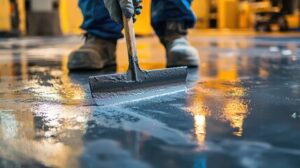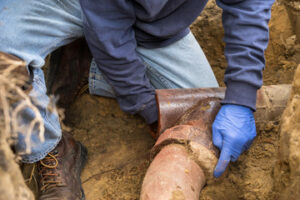Roof Repair Expert LLC is the process of correcting minor problems that can arise in a home’s roofing system. These issues include leaks, missing shingles, and structural damage like sagging.

Use a garden hose to simulate rain and find the source of the leak. If the spotter can’t see the leak inside, they should spray water on the left and right sides of the house to isolate the area.
Even a single damaged shingle can lead to serious roof problems, especially if it’s in an important spot like a seam or near a gutter. Water seeks out the lowest point and can seep through a cracked shingle, damaging the underlayment and causing leaks inside the home. Replacing a single shingle can prevent this from happening and can help protect your home.
To replace a shingle, first remove the surrounding shingles from the damaged area to ensure the underlayment is dry and free of any debris. Then, carefully pry up the shingle using a pry bar to break the seal. Once the shingle is removed, pull out any remaining nails and clean the area. Then, place the new shingle in its place and secure it with roofing nails. Finally, apply a generous layer of roofing sealant to the edges of the shingle and place a weight on it for 24 hours to ensure that it adheres properly and creates a watertight seal.
If the shingle is curled or buckled, use a putty knife to flatten it before applying roofing sealant. Then, apply a thick bead of roofing sealant over the crack or tear and press down to close it. Finally, apply a second coat of roof sealant over the top of the shingle to ensure that it adheres firmly and provides maximum protection from moisture.
During the repair process, it’s also a good idea to check the flashing around chimneys and other structures on your roof for any signs of damage. Flashing is usually made of a thin metal material that helps direct water away from the structure. If this is damaged, it should be replaced.
When performing shingle repairs, it’s a good idea to work with a professional roofing contractor. This will ensure that the job is done correctly and can help you save money in the long run by reducing future costs. In addition, many shingle manufacturers require that any roofing repair work is performed by a licensed and insured professional to ensure the warranty remains in effect.
Repairing Gaps
Ideally, rainwater and snowmelt flow off the roof and into gutter channels that lead it away from the building. Gaps between the roof and gutter systems, however, can allow water to saturate the ground or siding, potentially causing damage. Keeping these gaps minimal is an important part of regular roof maintenance. Drip edge flashing, for example, helps direct water into the gutters and prevents gaps from developing.
Gaps between the roof and gutter system can result from poor roof or gutter installation, a builder’s gap (created when builders don’t level the roof decking with the fascia boards that hold the gutters), and a variety of other reasons. Whatever the reason for the gap, it is important to repair these gaps quickly to minimize water leak risks and other problems.
To fix these gaps, first remove any debris that is stuck in the crack. Use a ladder to safely access the damaged areas and take a look at the problem. It’s best to inspect these areas during a dry period.
For small holes and cracks, fill the gap with a caulk or sealant suited to the material of the roof. A good choice is silicone or advanced polymer formulas that offer flexibility and adherence to the roof structure. For longer cracks and gaps, you can also use fiberglass scrim. For large holes and gaps, you’ll need to use a roofing cement. Apply a thin layer of this cement with a putty knife or caulking gun, spreading it evenly to cover the gap and its surrounding area.
Repairing Leaks
If your roof has a leak, it’s important to fix it promptly before water damage occurs. In many cases, you can repair a leaky roof without needing to replace the entire roofing system. The extent of the damage and where the leak is located will determine how much work is required. The best way to find the source of a leak is to do a visual inspection of the roof from both inside and outside the house. Look for water stains, water dripping and areas where shingles are missing. Check the area around roof penetrations like chimneys, vents and skylights for signs of deterioration. Also, inspect gutters and downspouts for clogging, which can lead to standing water on the roof that will eventually cause leaks.
For minor leaks, you may be able to use roofing sealants or caulking. However, keep in mind that these are only temporary fixes. If a leak has caused serious water damage to your home, you will need to replace the damaged materials and repair any structural issues.
Identifying the leak can be tricky. It’s usually easiest to do a walk-around of the entire interior of your house, keeping an eye out for water stains, drips and spots where the ceiling feels soft or spongy. If you have an attic, go up there to locate the source of the leak – it’s often not directly above the water stain on the ceiling. The water could be seeping down wood beams or through electrical wiring that runs along the ceiling.
Once you’ve found the leak, it’s important to clean the affected area thoroughly before making any repairs. This will remove any dirt, debris or rust that can prevent your new repair materials from adhering properly. Also, if the issue is caused by loose or aged screws or flashing, you will need to tighten them and replace any cracked or worn washers. Finally, if the leak is due to poor drainage, it’s important to install additional drainage points or modify the slope of the roof to improve water runoff and prevent future pooling.
Repairing Sagging
If your roof is beginning to sag, it’s important to take the time to inspect it thoroughly. A sagging roof is not just a cosmetic concern, but it can also indicate serious underlying issues that could compromise the structural integrity of your home.
The roof’s primary function is to protect the interior of your home from rain and snow, but it can be vulnerable to damage caused by many different factors. Some of these problems can be fixed by a professional roofer, but others may require the replacement of the entire roof.
While a small amount of sagging isn’t necessarily cause for alarm, it is a sign that your roof is overburdened with weight or has been damaged by water. A professional inspection can help determine the extent of the problem and recommend a course of action.
Sagging is often caused by an overabundance of snow or debris, but it can also be the result of a number of other issues. Water leaks and rot can weaken the underlying materials, causing them to collapse under their own weight. Poor construction or installation can also contribute to a sagging roof, especially if the roof isn’t properly insulated.
Even if your roof was built with quality materials, it will eventually begin to wear out and sag over time. Fortunately, it’s possible to extend the life of your roof through regular maintenance and roof inspections.
It’s also important to identify and address any underlying problems that can lead to sagging in the future, like a poor drainage system or clogged gutters. These issues can quickly become dangerous and compromise the structure of your home.
While some homeowners are tempted to try a DIY approach to repairing sagging roofs, this is typically a bad idea. Inexperienced homeowners can easily cause further damage by using improper methods of inspection or repairing the sagging roof. In most cases, it is significantly less expensive and more convenient to hire a professional roofer for a comprehensive assessment and repair. This can include sistering rafters, reinforcing the trusses, or adding steel gusset plates to strengthen the roof’s core structural elements.







